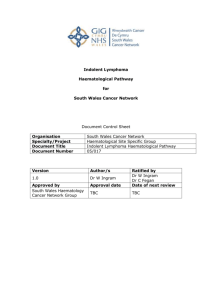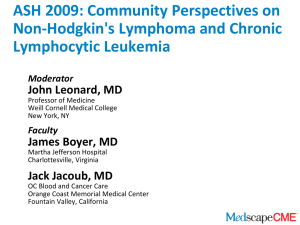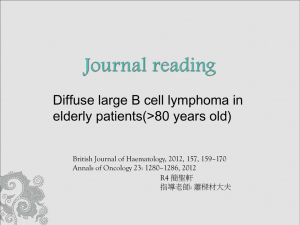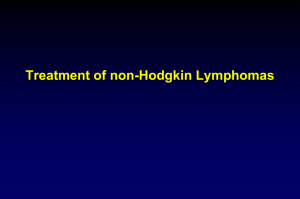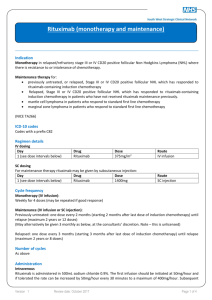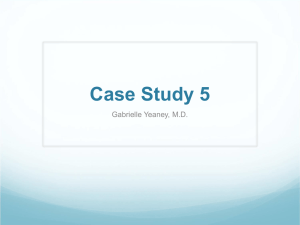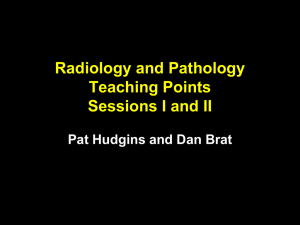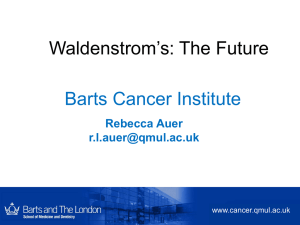Rituximab
advertisement
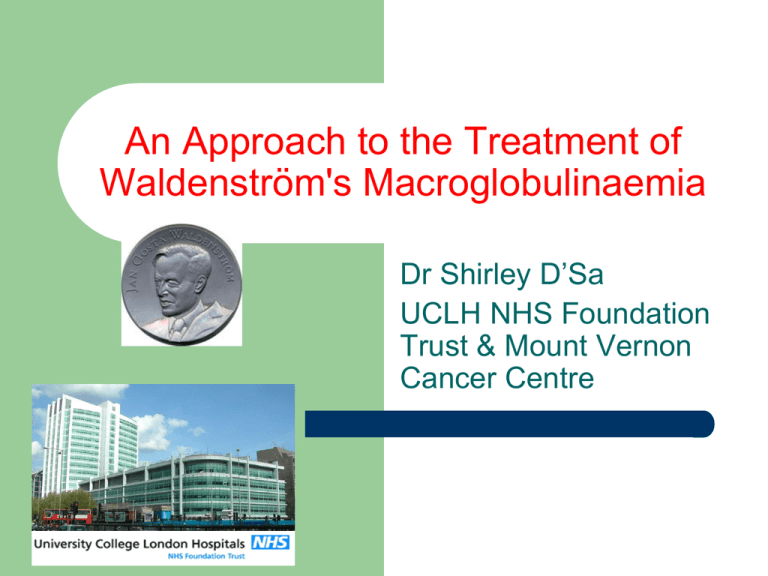
An Approach to the Treatment of Waldenström's Macroglobulinaemia Dr Shirley D’Sa UCLH NHS Foundation Trust & Mount Vernon Cancer Centre International WM workshops Washington 2000: 19 investigators, 4 countries Athens 2002: 55 investigators, 9 countries Paris 2004: 57 investigators, 13 countries Kos 2007: 150 persons (part of the Myeloma Workshop) Stockholm 2008 Venice 2010: 200 people, 17 sessions with 80 technical presentations from over 90 speakers, including 14 young investigators, 5 guest presentations, 5 debates, and 2 consensus panel discussions http://www.wmsupportgroup.org.uk Is it really WM/LPL? Which disease entities come under the label of WM/LPL? – – – – Other kinds of lymphoma also produce an IgM paraprotein – LPL plus IgM LPL plus IgA or IgG Cut-off for amount of paraprotein or lymphoma cells in the BM BM vs. lymph node involvement B-CLL, Marginal Zone Lymphoma, Monocytoid B cell lymphoma Expert review by a ‘Haematopathologist’ is essential Owen RG, Treon SP, Al-Katib A, et al. Clinicopathological definition of Waldenstrom’s macroglobulinemia: consensus panel recommendations from the Second International Workshop on Waldenström’s Macroglobulinemia. Semin Oncol. 2003;30(2):110-115. Bone marrow biopsy NORMAL LYMPHOMA Making the diagnosis – – – IgM MGUS: PP <30g/l; BM lymphocytes< 10%; no symptoms; no discernible lymphoma Only 25% of IgM MGUS will develop a symptomatic lymphoproliferative disorder within 15 years Cumulative probability of progression is 1.5% per year >> Follow up every 6-12 months Kyle RA, Rajkumar SV, Therneau TM, Larson DR, Plevak MF, Melton LJ III. Prognostic factors and predictors of outcome of immunoglobulin M monoclonal gammopathy of undetermined significance. Clin Lymphoma. 2005;5(4):257-260. Increasing number of lymphoma cells MGUS Asymptomatic WM Symptomatic WM Asymptomatic WM IgM > 30g/l – Bone marrow lymphoma cells > 10% – No symptoms – No anaemia – No viscosity problems – No enlarged lymph nodes or spleen The risk of progression to symptomatic WM is 6% per year Only 55% of patients with smouldering WM will progress within 5 years No evidence to date that the treatment of smouldering/asymptomatic WM provides a survival benefit compared to starting treatment once symptoms occur – >> Follow up every 4-6 months Kyle RA, Benson J, Larson D, et al. IgM monoclonal gammopathy of undetermined significance and smoldering Waldenström’s macroglobulinemia.Clin Lymphoma Myeloma. 2009;9(1):17-18. Alexanian R, Weber D, Delasalle K, Cabanillas F, DimopoulosM. Asymptomatic Waldenström’s macroglobulinemia. Semin Oncol.2003;30(2):206-210. Is treatment required? ¼ of patients are diagnosed by chance ½ of patients who do not have symptoms or do not need treatment at diagnosis will not require treatment for 3 years 1 in 10 patients will not need treatment for 10 years Garcia-Sanz R, Montoto S, Torrequebrada A, et al. Waldenström macroglobulinaemia: presenting features and outcome in a series with 217 cases. Br J Haematol. 2001;115(3):575-582. Ghobrial IM, Fonseca R, Gertz MA, et al. Prognostic model for disease-specific and overall mortality in newly diagnosed symptomatic patients with Waldenström macroglobulinaemia. Br J Haematol. 2006;133(2):158-164. When to start treatment? What are the triggers for starting treatment? – – – Symptoms- fever, night sweats, weight loss, fatigue due to anaemia Increasing size of lymph nodes or spleen Low blood counts (typically Hb < 10g/dl, platelets < 100) due to the presence of the lymphoma in the marrow – – – But should be tailored to the patient’s situation, rate of change High blood viscosity Worsening peripheral neuropathy symptoms Rare complications such as amyloidosis, cryoglobulinaemia Plasma Viscosity Plasma viscosity can be measured in some labs – – Hyperviscosity Syndrome: – – – Normal plasma 1.4-1.8 x water Normal blood ~3 x water Affects 10-40% of WM patients with IgM > 50g/l Headache, lethargy, confusion, irrational behaviour, visual disturbance, seizures, strokes or angina Bleeding manifestations include gum and nosebleeds Plasma exchange: – – – Indicated for symptomatic patients at any level May be required prior to blood transfusion Certain centres only Treatment Considerations PATIENT FACTORS: Is there a possibility of a stem cell transplant now or in the future? >> important to AVOID treatments that will damage stem cells or affect the ability to harvest What other health-related factors need to be taken into account? – – Frail or fit Other medical problems such as high BP, diabetes, heart disease, kidney disease Any current problems such as neuropathy which could be made worse by certain treatments? Treatment Considerations WM-RELATED FACTORS: What is the IPSSWM? 5 ‘adverse features’: Age > 65, Hb < 11.5, Plats < 100, β2microglobulin > 3mg/l, IgM > 70 g/l – 3 risk groups with 5 year survival rates of 87%, 68%, 36% Patients with more adverse features may need more intensive treatment to overcome this disadvantage – – – Higher chemotherapy doses Combinations of different agents Inevitably more toxic effects What treatments are available? Chlorambucil – Purine analogues: Fludarabine, Cladribine – Tablet taken as outpatient, may cause low blood counts, v few side effects, well tolerated, effective Oral or intravenous, outpatient or day case, suppresses the immune system profoundly for many months (need preventive medication), low blood counts, can affect stem cell collections Adding other drugs generally improves the response rate but may also increase the side effects Rituximab- anti-CD20 monoclonal Ab Works in WM because it is a B cell lymphoma and has CD20 on its surface Produces major responses in 27-35% of previously treated and untreated patients Better blood counts and reduction of bulky disease Standard dose 375 mg/m2 weekly for 4 weeks Time to response following Rituximab alone > 3 months on average Patients with IgM of <60 g/l are more likely to respond Improves the response to treatment when added to chemotherapy Rituximab May be given alone or in combination with chemotherapy Given intravenously as a day case First infusion lasts 6 hours Main side effects occur at the time of the infusion due to the body’s reaction to the drug (a protein) Subsequent infusions may be as short as 90 minutes as reactions are much less likely to occur at this point If the initial IgM level is >40g/l, Rituximab may cause a further temporary rise in the level with a risk of viscosity problems Long term side effects are few: lowered immunity, increased risk of infections, possibility of low white cell count, v rarely inflammation and stiffening of the lungs Rituximab Both response rates and response duration may be improved by an extended Rituximab schedule (two 4-weekly courses of 375 mg/m2 given 3 months apart)- but more studies needed before this is a standard approach Maintenance Rituximab (Rituximab given as a single agent every 2-3 months for 2 years after completion of initial treatment) has been shown to prolong remissions in some forms of lymphoma but this has not been validated in WM In many parts of the UK, specific permission to prescribe Rituximab in WM patients has to be sought What other treatments are available? CHOP/CVP: comparable response rates to other treatments (e.g. Chlorambucil) More rapid, but greater toxicity. Does not compromise subsequent stem cell harvesting R-CHOP is superior to CHOP alone in WM patients (94% vs. 69%) Buske C, Dreyling MH, Eimermacher H, Boeck H-P, Pfreundschuh M, Metzner B, et al. Combined Immuno-Chemotherapy (R-CHOP) Results in Significantly Superior Response Rates and Time to Treatment Failure in First Line Treatment of Patients with Lymphomplasmocytoid/ic Immunocytoma (LP-IC) - Results of a Prospective Randomized Trial of the German Low Grade Lymphoma Study Group (GLSG). ASH Annual Meeting Abstracts 2004;104(11):162 DRC: Dexamethasone 20 mg iv on day 1, Rituximab 375 mg/m2 on day 1 and Cyclophosphamide 100 mg/m2 bd orally on days 15 given on a 21 day cycle for 6 courses Dimopoulos MA, Anagnostopoulos A, Kyrtsonis MC, Zervas K, Tsatalas C, Kokkinis G, et al. Primary treatment of Waldenstrom macroglobulinemia with dexamethasone, rituximab, and cyclophosphamide. J Clin Oncol 2007;25(22):3344-9. What other treatments are available? Stem cell transplantation – – From self (autologous stem cell transplantation) From donor (allogeneic stem cell transplantation) Age > > 65 years, not for stemnot cell Age 65 years, transplant for stem cell transplant Frailer patient, slowly progressive disease, adequate marrow reserve Frailer patient, gradual disease, adequate marrow reserve Chlorambucil 8 mg/m2 /day for 7-10days every 4-6 weeks +/Prednisolone 1 mg/kg/day for 7-10days every 4-6 weeks Cytopenias, high M-protein (clinical decision dictates the level of M-protein that is regarded as high, taking account of co-morbidities) Cytopenias, low M-protein (at Low a level that is low enough to allow blood counts, gradual reduction) Peripheral neuropathy low M-protein (low enough to allow gradual reduction) Peripheral neuropathy DRC x 6 Low blood counts, high M-protein R-CVP every 3-4 weeks up to 6 cycles (Consider R from cycle 2 if M-protein>40g/l) Or Or Fludarabine 40 mg/m2/day po for 3-5 d every 28d +/- R Max 6 courses Single-agent Rituximab (375mg/m2 weekly for 4 weeks) +/- repeat after 3 months DRC x 6 R-CVP Or Chlorambucil YES Watchful waiting until relapse Or >PR or adequate symptom control Fludarabine Rituximab NO Depends on first line agent used, duration and quality of response, tolerance of initial treatment, real-time age and performance status: >12 months response: retreat with initial drug If <12months response: consider initial agent plus additional drug or alternative class of drug. If no prior Rituximab, consider it now. Age < 65 y At least 2 of the following poor prognostic factors: Hb < 11.5 g/dl, platelets <100 x 109/l, 2 microglobulin > 3, M-protein>70g/l Yes No And/or need to reduce burden of lymphoma quickly R-CHOP or DRC R-Cladribine Stem cell harvest Stem cell transplant W&W What other treatments are available? Bortezomib Bendamustine Thalidomide New monoclonal antibodies – – Ofatumumab GA101 Conclusions As a result of increased activity on the part of physicians and lay people alike, the outcome for WM patients is improving Improved understanding of the origins and behaviour of WM is leading to more effective therapy Newer agents are being developed to tackle the disease >> a brighter outlook for WM patients
